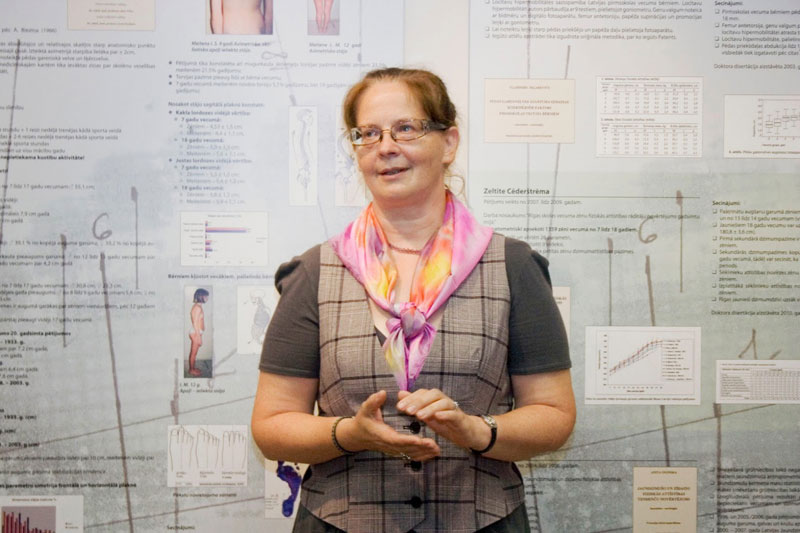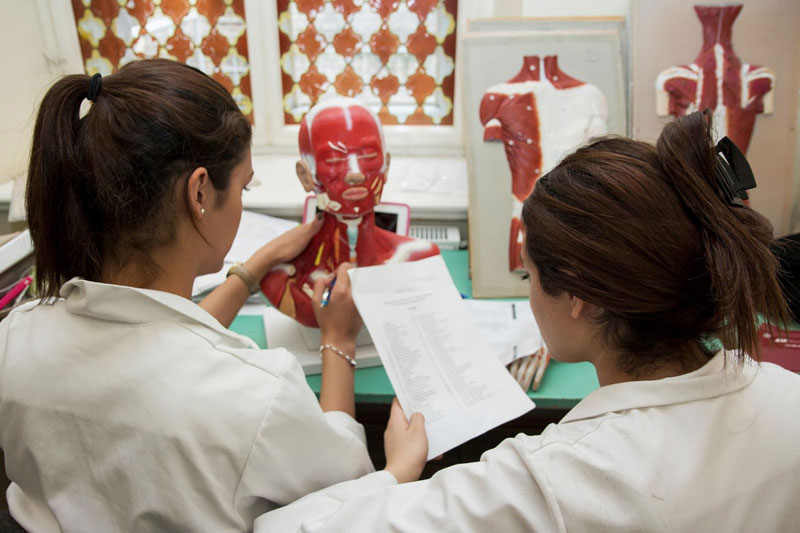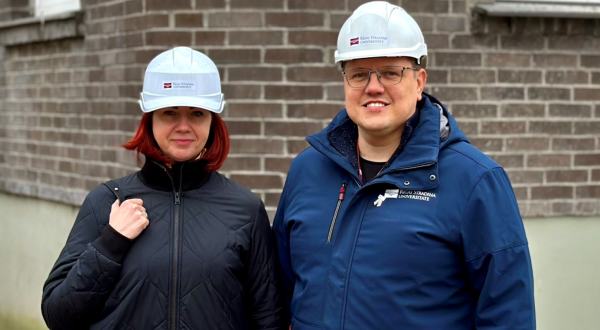Anatomical Theatre - where death is given due respect
Earlier this month we caught up with the director of RSU Institute of Anatomy and Anthropology (Anatomical Theatre) Professor Māra Pilmane to discuss subjects for the training of prospective physicians and morals and ethics of the 21st century

What changes, if any, has the anatomical theatre experienced lately?
As you see, the anatomical theatre is undergoing reconstruction. This is already the third, however the most fundamental reconstruction undergone since the 1980s. The improvements are comprehensive – paved inner yard, a students’ area and practically complete reconstruction of the entire building. We gladly tolerate the inconvenience, since we expect that the anatomical theatre will be spruced up – a masterpiece like never before! The deepest gratitude should be extended to the university’s rector, Department of Infrastructure and everyone involved in the construction work.
In addition to that we are looking forward to the construction of the museum. The former horse stable building in the yard will be turned into the RSU museum which will also become the location of the anatomical exhibition, formerly the Jēkabs Prīmanis Museum of Anatomy. Up till now it was under the administration of the Museum of the History of Medicine and today it is officially coming back home, seeing as this was previously our collection. I am very pleased about the way things are coming together.
The anatomical theatre will now host two museums – a branch of Jēkabs Prīmanis Museum of Anatomy which will be incorporated into the RSU museum and the collection or exhibition of our Institute of Anatomy and Anthropology from which we can take preparations and tissues more freely than, for example, from a state museum.
I get a warm feeling even imagining how beautiful it will be! I think that we -the entire university - have long deserved it!
We have introduced modern technologies into the study process. Last year we purchased a modern virtual 3-dimensional dissecting table which has stirred up much interest not only in Latvia but even Europe-wide. Our colleagues from Tartu and Vilnius have come to see it and now are purchasing identical equipment for themselves.
It is a unique purchase, the operating table allows for the dissection of life-like human bodies of both genders in electronic form, perform various incisions, rotate the image etc. The table contains 600 diverse clinical cases with x-ray images, dissection and structure repetition modes.
I would find it hard to think of something we do not have! Our anatomical theatre has everything! We desire an anatomical hologram programme, however there is currently no such programme available anywhere in the world – it is still in in initial stages of development.
What is on your and your colleagues' minds as the New Year approaches?
I think we have to intensify the discussion on ethics with the general public and, definitely, with students. This is the century of ethics! Students should keep this in mind as soon as they step over the anatomical theatre’s threshold. This is a place where death helps the living. Death should be honoured and respected, treated with due care, as far as the anatomical theatre displays bodies of the deceased.
The taking of photos is prohibited in the anatomical theatre and this is not just a capricious idea on our part. People who have donated their bodies to science and medicine would not be happy to know that the pictures of their bodies are posted on social networks and commented on. It is morally wrong and deeply unethical conduct!
If it is hard to understand, I have to remind that this is a violation which can lead to exclusion from the university. We have to show due respect to those who have given thought to the prospective medical practitioners who could learn from them.
Natural study materials provided by the anatomical theatre should be handled with care. It is also prohibited to obtain anatomical materials by illegitimate means – occasionally practiced in the years of Soviet rule. A true medical practitioner is not one with a skull at home, this, forgive me for saying, is a medieval perception and it is quite a surprise that no criminal proceedings have been initiated against them. There are two locations for dead tissue: the graveyard or the anatomical theatre.
I would like to take this opportunity and urge all colleagues who have inherited human bones or skulls from the Soviet era which was lacking in ethical consciousness and return them to the anatomical theatre. We will accept and register these articles which will afterwards officially serve in educating future medical practitioners. The second option, of course, is to wait for the police to arrive and explain the situation to them. There is also a third one – which, I would not deem to be entirely official – to bury the skull yourself. Let's respect the fact that possession of a deceased person’s tissue is prohibited!
The regulations of the anatomical theatre are binding upon everyone entering the theatre. Another thing to be respected is that upon entry into the anatomical theatre you must take your hat off. It has to be remembered that in Latvia men pay tribute to the deceased by taking their hats off. This is an integral part of our culture. In this way we give due respect to the dead.

As you already mentioned, modern technologies are introduced into the study process, but is it possible to study anatomy without natural materials?
The cycle of believing that medicine can be acquired using only virtual anatomy and plastic modules, has come full circle. It was already loudly announced in 2008 during the annual congress of the International Federation of Associations of Anatomists - that we, colleagues, were wrong in thinking that human anatomy can be mastered by looking at plastic models and now we are returning to prosection. The world's largest medical universities have gone down this path of returning to where we started. We are glad that RSU anatomical theatre has never given up on prosection. Thus, we have always been keeping up with the times.
We have been facing a number of unexperienced and at times embarrassing issues lately....
For example a person devotes his body to anatomical study and commits suicide afterwards. Such situations make us contemplate on the following: donation of one’s body to medicine is a generous and charitable gesture without any monetary reward. This is a mature decision, commonly not taken overnight, there are cases when people call the anatomical theatre to discuss this issue.
Suicide corpses present a truly severe moral and ethical dilemma and we are forced to think of where the gesture of charity has vanished, considering that a person committing suicide is unable to demonstrate charity towards himself. This consideration seriously hinders us from accepting the body. Moreover, every suicide is first investigated by the police and therefore we practically always refuse to accept the body.
Another moral and ethical issue which has gained topicality in the last few years is that relatives address the anatomical theatre with the willingness to donate the body of a person to medicine while the person is still alive. I have to think of where our society is heading to. What are the reasons behind it? Could it be because of financial considerations – no funeral arrangements, death allowance received… I would hate to think I have guessed correctly! The anatomical theatre is not a kind of service which accepts bodies of the deceased in the case of the relatives not being able to afford to bury them. Such cases confuse us. We treat the bodies of deceased with deep respect and are grateful to persons who have donated their bodies to medicine; however, there is room for the question on whether it indeed has been a gesture of charity. What have been the underlying reasons for making this choice? Maybe this is the area of police authority? What has happened to deeply ethical issues faced by the community? We ourselves have no answer to these questions.
The age of social networking unfortunately has thrown open the gate of permissiveness, despite that, no moral and ethical norms have been abolished! Every prospective medical practitioner should remember this!
Where and when can RSU medical students access natural and artificial bones, skulls etc. for proper anatomy studies?
The anatomy laboratory, where every student can work with artificial and natural materials by presenting his/her student card is open not only on weekdays but also on Saturday. Students take the materials they need, find a cosy place for acquiring knowledge, study them and return the materials to the laboratory the same day. The old problems with availability of materials are history, at present all materials are freely accessible to students. In case you intend to visit us on a Saturday, we would advise that you apply in advance, as far as the availability of technical staff is limited and we have to first assist students who have registered their needs beforehand. Commonly there are no problems with this procedure which has been accepted by local and also foreign students.
Related news
 RSU is growing and developing: major reconstruction underway in the main buildingDevelopment, For RSU Employees, For Students
RSU is growing and developing: major reconstruction underway in the main buildingDevelopment, For RSU Employees, For Students


